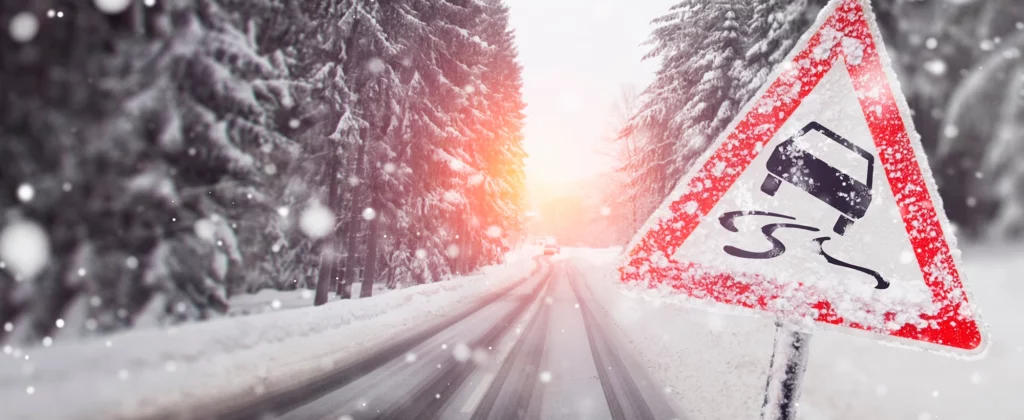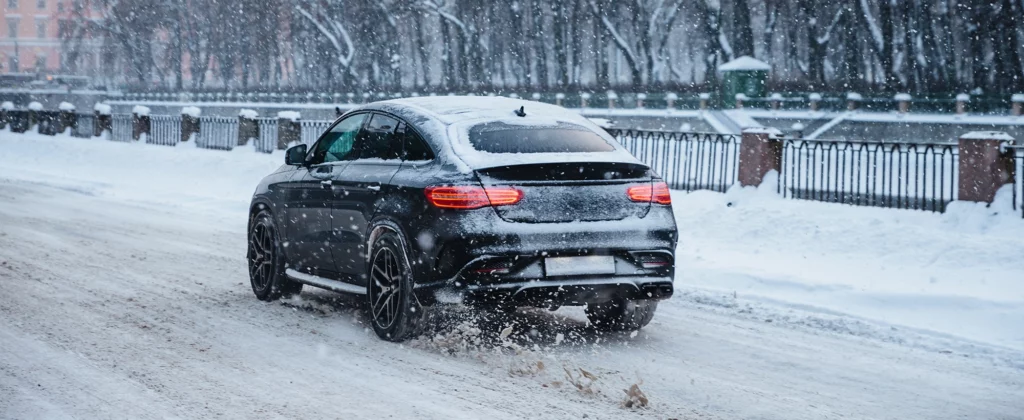Winter driving is fraught with challenges that require extra caution and preparation. Roads blanketed with snow, hidden patches of black ice, and reduced visibility can turn a routine drive into a dangerous journey. Each year, thousands of accidents are caused by winter road hazards, often due to a lack of preparation or overconfidence behind the wheel.
Understanding the risks and equipping yourself with the right knowledge and tools is essential for staying safe on icy and slippery roads. This guide will explore how to prepare your vehicle, adjust your driving techniques, and handle common winter road hazards with confidence.
- Why Winter Roads Are Hazardous
- Recognising and Avoiding Slippery Conditions
- How Cold Weather Impacts Driving Dynamics
- Preparing Your Vehicle for Driving in Winter
- Driving Techniques for Winter Roads
- Understanding Vehicle Weight Distribution in Winter
- Winter Driving for Longer Journeys
- Navigating Winter Storms Safely
- Safe Night-Time Winter Driving
- Post-Winter Care for Your Vehicle
- Common Winter Driving Concerns
Why Winter Roads Are Hazardous

Winter road conditions are inherently risky due to a combination of reduced traction, poor visibility, and unpredictable weather patterns. Snow, while visible, can compact into an icy surface, reducing grip. Slush, a mix of melting snow and water, can cause vehicles to hydroplane much like standing water during heavy rain. The most insidious hazard, however, is black ice. This thin, transparent layer forms on shaded areas, bridges, and overpasses, often without warning. With black ice, even small movements can cause a loss of control.
Adding to these challenges are freezing rain, frost, and snow drifts that obscure road markings. Coupled with the longer stopping distances and impaired steering associated with icy roads, these factors make winter driving one of the most dangerous seasonal activities.
ℹ️ In the UK, nearly a quarter of weather-related road accidents in the UK occur on snowy or icy roads.
Recognising and Avoiding Slippery Conditions
Awareness is your best defence against winter road hazards. Learning to identify potential trouble spots can help you navigate safely.
Spotting Black Ice
Black ice often looks like a wet patch on the road. Pay close attention to shaded areas, bridges, and overpasses, especially in freezing temperatures or after a rainstorm. If you suspect black ice, reduce your speed and avoid sudden movements.
Navigating Snow and Slush
Snow can obscure hazards like potholes or ice patches, so drive cautiously. Slush, which forms when snow partially melts, can cause vehicles to hydroplane. Maintain a firm grip on the steering wheel and avoid sharp turns or sudden braking.
Handling Hills and Inclines
On steep hills, keep your momentum steady when climbing. Avoid stopping midway, as starting again can be difficult on a slick incline. When descending, switch to a lower gear and use gentle braking to maintain control.
How Cold Weather Impacts Driving Dynamics

Winter weather conditions affect your vehicle’s behaviour and its ability to maintain traction on the road. The combination of cold air and icy surfaces alters the way your car responds to acceleration, braking, and steering, requiring extra care to maintain control.
Sluggish Tyre Response
Cold air causes tyre rubber to stiffen, reducing its ability to grip the road effectively. Even high-performance tyres designed for wet conditions may struggle when temperatures plummet. This is especially noticeable during sharp turns or sudden stops, where traction is already limited. Regular tyre checks and adjustments ensure optimal performance in these conditions.
Changes in Brake Performance
Brakes can feel less responsive in cold weather, especially if moisture has frozen within the braking system or if your brake pads are worn down. Longer stopping distances are common, even with fully functional brakes. Anticipate these changes by braking earlier and more gently than you would in normal conditions.
Delayed Steering Reaction
Winter road conditions often make steering more sluggish, particularly on icy patches or packed snow. This is compounded by the reduced responsiveness of tyres in cold weather. Practising smooth and deliberate steering inputs can help compensate for these limitations, preventing overcorrection and skidding.
💡 Give your car a few minutes to warm up before driving. This helps the engine run smoothly, ensures proper oil circulation, and improves visibility by defrosting windows.
Preparing Your Vehicle for Driving in Winter

The foundation of safe winter driving begins with a properly equipped and maintained vehicle. Ensuring your car is ready for icy and snowy conditions can significantly reduce risks.
Winter Tyres and Snow Chains
Investing in winter tyres is crucial for navigating icy roads. Their specialised rubber compounds remain flexible in cold temperatures, while deeper treads improve grip on snow and ice. For areas with heavy snowfall, snow chains can provide additional traction, particularly on steep or rural roads.
Battery, Brakes, and Fluids
Cold weather can significantly reduce battery performance. Have your battery tested and replaced if it shows signs of weakness. You can also use a battery monitor app to keep an eye on your devices’ battery lives. Your brakes should also be in top condition, as they are critical for handling sudden stops on slippery roads. Lastly, check and refill essential fluids such as coolant, oil, and windshield washer fluid with formulations suited for freezing temperatures.
Visibility and Emergency Supplies
Good visibility is essential in winter driving. Replace worn wiper blades and clear your windows and mirrors of snow and ice before hitting the road. Always carry an emergency kit that includes an ice scraper, snow shovel, blankets, extra clothing, water, snacks, a torch, and a first-aid kit. A fully charged mobile phone and a car charger can also be lifesaving if you get stranded.
💡 Tire pressure drops by ~1 PSI for every 10°C (18°F) decrease. Low pressure affects traction and fuel efficiency. When the outdoor temperature starts to drop, be sure to check and inflate to the recommended level regularly.
Stay safe on the road this winter with the AA Emergency Winter Kit. Includes a snow shovel, de-icer, thermal blanket, and more for ultimate preparedness in freezing conditions.
Driving Techniques for Winter Roads

Driving on icy or snowy roads requires adapting your approach to accommodate reduced traction and visibility. Here are essential techniques for staying safe.
Understanding Your Vehicle’s Drivetrain
Your vehicle’s drivetrain significantly impacts how it will handle on icy or snowy roads. Knowing your car’s driving dynamics, capabilities and limitations can help you adapt your driving techniques.
Rear-Wheel Drive (RWD)
RWD vehicles send power to the rear wheels, making them prone to oversteer in slippery conditions. These vehicles are particularly susceptible to losing traction icy roads, especially when turning or driving on inclines. Accelerate gently and maintain a steady, moderate speed to avoid the risk of oversteer (losing grip on the rear wheels) and wheelspin.
Front-Wheel Drive (FWD)
FWD vehicles send power to the front wheels, which makes them more stable in snow and less prone to losing traction compared to RWD vehicles. However, they are more prone to understeer (losing grip on the front wheels) when turning too sharply. Avoid excessive acceleration to prevent potential understeer and wheelspin.
All-Wheel Drive (AWD)
AWD vehicles send power to all four wheels, giving you better traction overall in icy and slippery conditions. However, they are not immune to slipping and tend to weigh more than RWD or FWD cars due to their additional components. Accelerate moderately and always exercise caution when turning or driving on inclines.

Adjusting Your Speed
Slower speeds give you more control and reduce stopping distances. Even if the speed limit remains unchanged, drive at a pace suitable for the conditions. Maintain a greater following distance—at least double the normal gap—to give yourself more time to react.
Braking and Accelerating
Smooth, steady movements are key. Accelerate gently to prevent your tyres from spinning. When braking, apply steady pressure to avoid locking the wheels. If your car is equipped with anti-lock brakes (ABS), press the pedal firmly and let the system do the work. Without ABS, use a technique called threshold braking: apply firm but controlled pressure without locking the wheels.
Recovering From Skids
If your car begins to skid, stay calm and avoid slamming the brakes. Instead, steer gently in the direction you want the car to go. For rear-wheel skids, ease off the accelerator and steer into the skid. For front-wheel skids, gently ease off the throttle until traction is restored.
💡 Avoid using cruise control on slippery roads; it can reduce your ability to react quickly.
Understanding Vehicle Weight Distribution in Winter
The distribution of weight in your vehicle plays a significant role in how it handles icy and snowy conditions. Adjusting the load and driving style to account for weight changes can help improve traction and stability.
Why Weight Matters
A heavier vehicle may provide better traction on snowy roads, but it also takes longer to stop. Conversely, lighter vehicles are more prone to sliding, especially when travelling downhill. Adding weight to the back of your car—such as sandbags in the boot—can improve stability, especially for rear-wheel drive vehicles.
Avoiding Uneven Loads
Unevenly distributed weight can make your car harder to control. For example, a heavy load in the rear can reduce traction at the front wheels, impairing steering. Distribute weight evenly across your vehicle to maintain balance.
Adapting to Passengers or Cargo
Carrying passengers or heavy cargo requires adjusting your driving style. Allow for longer stopping distances and be aware of how the extra weight impacts cornering. Slow down before entering turns to avoid losing control.
Winter Driving for Longer Journeys

Driving longer distances in winter introduces unique challenges, as conditions can change dramatically over the course of your trip. Proper planning and preparation are key to completing your journey safely.
Planning Ahead
Check weather forecasts not only for your departure point but also for your entire route. Bring extra supplies, including food, water, and blankets, in case delays or closures force you to stop unexpectedly. Knowing alternate routes ahead of time can help you avoid unsafe areas.
Managing Fatigue
Winter driving is more mentally taxing than driving in clear conditions. The constant need for vigilance against hazards like black ice and poor visibility can lead to fatigue. Plan breaks every two to three hours, and never push through tiredness—rest is critical for maintaining focus.
Fuel Efficiency in Cold Weather
Fuel consumption increases in winter due to the extra strain on your engine and other systems. Top off your tank before long trips and keep it at least half full to avoid running out in case of delays or emergencies.
💡 Monitor forecasts for the entire route and prepare for sudden changes in conditions.
This easy-to-use tire gauge features an ergonomic handle and backlit LCD screen, with PSI/BAR settings up to 100PSI/6.55BAR. Conveniently small, it fits in your glovebox, door pocket, or center console. Economical with an automatic shut-off after 30-90 seconds, its nozzle ensures accurate measurement.
Navigating Winter Storms Safely

Winter storms can create sudden and severe driving challenges, including heavy snowfall, strong winds, and plummeting temperatures. Knowing how to adapt to these conditions is vital for staying safe.
Driving Through Whiteouts
Whiteouts occur when blowing snow drastically reduces visibility. To navigate through these conditions, slow down and use your low-beam headlights to improve visibility without reflecting light off the snow. Avoid stopping in the middle of the road, as other vehicles may not see you in time to stop.
Managing Wind and Snow Drifts
Strong winter winds can blow snow across the road, forming drifts that reduce traction and create uneven surfaces. When encountering a drift, approach slowly and keep your wheels straight to avoid getting stuck. If possible, avoid roads known to accumulate large drifts during storms.
The Dangers of Frost Heaves
Frost heaves are raised sections of pavement caused by freezing and thawing cycles. These bumps can destabilise your vehicle if hit at high speed. Stay vigilant for uneven patches of road and reduce your speed when travelling on unfamiliar routes.
Safe Night-Time Winter Driving

Winter nights bring additional risks, from reduced visibility to plummeting temperatures that exacerbate road hazards. Preparing for these challenges can make night driving safer and less stressful.
Maximising Visibility
Clean your headlights and ensure they are properly aligned to illuminate the road without blinding oncoming drivers. Use high beams only in areas with no oncoming traffic or streetlights, as snow or fog can reflect the light back and reduce visibility.
Spotting Wildlife
Many animals are more active during the winter months, especially at night. Keep an eye on the sides of the road and reduce your speed in rural areas to avoid collisions with wildlife, which can cause significant damage to your vehicle.
Staying Warm and Prepared
If you become stranded at night, staying warm becomes a priority. Carry extra blankets and ensure your phone is fully charged before setting out. Keep your engine running intermittently to conserve fuel while providing heat.
💡 Use your high beams in low-light areas to spot hazards in the road earlier, but dim them when vehicles are approaching in the oncoming lane.
Restore cloudy or faded headlights with the Autoglym Headlight Restoration Kit. Easy to use and includes everything needed to improve brightness and visibility, perfect for safer winter driving.
Post-Winter Care for Your Vehicle

Winter driving conditions can leave lasting effects on your vehicle, making post-season maintenance essential. The combination of road salt, ice, and freezing temperatures can lead to issues that, if unaddressed, might escalate over time.
Inspecting for Salt and Corrosion
Salt is a major culprit in causing rust, particularly on the undercarriage of your car. Pay extra attention to wheel wells, suspension components, and exposed metal areas. A thorough wash, especially targeting the underside, can remove built-up salt and debris, helping to prevent corrosion.
Switching Tyres for Warmer Weather
Once temperatures consistently rise above 7°C, it’s time to replace winter tyres with all-season or summer ones. Winter tyres wear down faster on dry, warm roads, and switching ensures their longevity. Check your tyres for any wear or damage before storage, and ensure they are kept in a cool, dry place.
Checking Brakes and Suspension
Winter’s harsh conditions can strain your brakes and suspension system. Inspect brake pads for wear and check for any signs of uneven suspension, which could indicate misalignment from driving over potholes hidden beneath snow. Addressing these issues early can improve your car’s handling and safety.
💡 Spray the underside of your vehicle with water after driving on salted roads to prevent rust buildup.
Easily clear your car windows with the AA Winter Ice Scraper and Chamois Demister Pad. Perfect for de-icing and removing condensation, ensuring safe and clear visibility on frosty mornings
Common Winter Driving Concerns

If your car starts to skid on icy or snowy roads, resist the urge to panic or slam on the brakes. Instead, focus on steering gently in the direction you want the car to go. Ease off the accelerator, and avoid making sudden movements. For rear-wheel skids, steer into the skid to regain control. For front-wheel skids, let go of the accelerator until traction returns.
Sudden snowstorms can reduce visibility and create treacherous road conditions. Always check weather forecasts before setting out, and ensure your vehicle is equipped with an emergency kit, including blankets, food, water, and a fully charged phone. If caught in a snowstorm, reduce your speed, turn on your headlights, and keep your wipers clear of ice.
Descending a hill in winter requires careful control. Shift to a lower gear before starting the descent, and use gentle, steady braking to maintain your speed. Avoid sudden movements or braking, as these can cause your wheels to lock and lead to a skid.
Black ice is difficult to detect because it blends in with the road. To minimise risk, drive slowly in areas where black ice is common, such as shaded sections of road, bridges, or overpasses. Keep your steering smooth and avoid abrupt braking or acceleration.
Avoid using cruise control on icy, snowy, or slippery roads. Cruise control can cause your vehicle to accelerate unexpectedly if the tyres lose traction, making it harder to regain control. It’s best to drive manually in winter conditions.
If weather warnings advise against travel, or if the forecast predicts severe ice, snow, or freezing rain, it’s safest to postpone your journey. No trip is worth risking your safety, and waiting for better conditions is always a prudent choice.

Make your winter journeys more memorable by recording them with Velocity GPS Dashboard.
Learn more about Velocity GPS Dashboard and download on Google Play:



